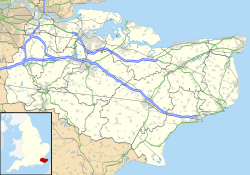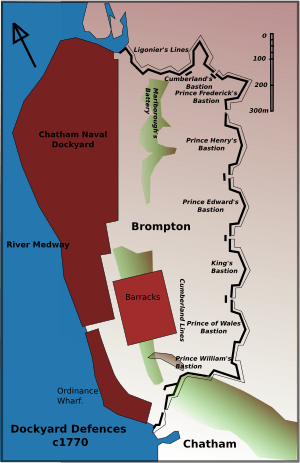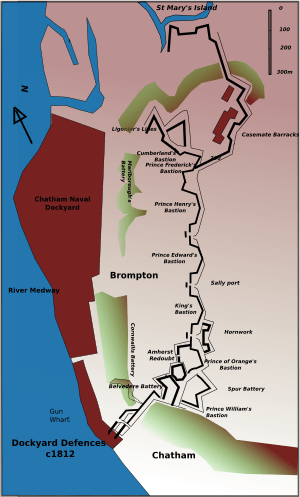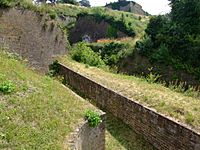Fort Amherst facts for kids
Quick facts for kids Fort Amherst |
|
|---|---|
| Medway, Kent, England | |
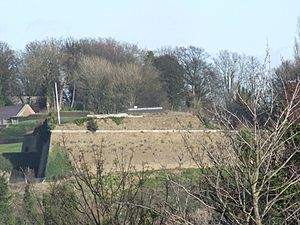
The fort's outer defensive walls, as seen from Fort Pitt
|
|
| Coordinates | 51°23′13″N 0°31′34″E / 51.387°N 0.526°E |
| Type | Napoleonic Fort |
| Site information | |
| Owner | Fort Amherst Heritage Trust |
| Condition | Intact |
| Site history | |
| Built | 18th century |
Fort Amherst is an old fort in Medway, England. It was built a long time ago, in 1756. Its main job was to protect the important Chatham Dockyard and the River Medway from attacks, especially from the French navy.
Today, Fort Amherst is a fun place to visit. You can explore its tunnels and learn about its history.
Fort Amherst: A Look Back in Time
Why Was Fort Amherst Built?
The main reason for building forts around Medway was to protect the Chatham Dockyard. This dockyard was a very important place where naval ships were built and repaired. In 1667, the Dutch navy attacked the dockyard and caused a lot of damage. This event showed how much the dockyard needed strong defenses.
Plans for these defenses started in 1708. Land was bought using special laws passed in 1708 and 1709. The first plan was to build a ring of defenses around the dockyard.
Building the First Defenses
In 1755, several parts of the fort were built. These included areas called 'Prince of Wales' Bastion and 'Kings Bastion'. A bastion is a part of a fort that sticks out, allowing defenders to fire along the walls. These new defenses, along with ditches, were built during the Seven Years' War (1756–1763). They became known as the Chatham lines.
Captain John Peter Desmaretze designed these defenses in 1755. They included a 9-meter (30-foot) wide ditch and a 3-meter (10-foot) high protective wall called a parapet. In 1757, a building for soldiers, called a barracks, was added to house the troops who would defend the fort.
Fort Amherst During the American War
During the American Revolutionary War (1778–1783), the defenses were made even stronger. The most important parts were two small forts called redoubts. 'Amherst Redoubt' was at the south end, and 'Townsend Redoubt' was at the north end. Amherst Redoubt later became the Fort Amherst we know today. Each redoubt had many cannons of different sizes, ready for battle.
Ancient Discoveries at the Fort
In 1779, while workers were building the fort, they found something amazing. They discovered the old foundations of a Roman building! They also found Roman bricks, tiles, and coins. One coin was from Empress Faustina, and another from Emperor Claudius. These finds were recorded by Lieutenant James Douglas, who later wrote a book about his archaeological discoveries.
Expanding the Fort During the Napoleonic Wars
The Napoleonic Wars (1803–1815) led to even bigger changes at Chatham. The defenses were greatly expanded and strengthened. More cannon batteries were added, and the ditches were lined with brick. General Hugh Debbrieg, a chief engineer, planned these improvements.
From 1802 to 1811, prisoners helped extend the tunnels and create huge underground storage areas and shelters. They also built new places for ammunition, more barracks, gun batteries, and guardrooms. Over 50 cannons were placed around the fort. The last building work finished around 1820. A complex network of tunnels was dug into the chalk cliffs to move ammunition safely around the fort.
Other Nearby Forts
Another fort, 'Townsend Redoubt', was built at the same time as Fort Amherst. Both forts were part of a larger defense system called the "Cumberland Lines." These lines surrounded the entire east side of the dockyard. Other forts, like Fort Clarence in Rochester and Fort Pitt, were built between 1805 and 1815 to protect the southern approaches.
Even though these strong defenses were never tested in a real invasion, they would have been very difficult for any enemy to attack.
Fort Amherst After the Wars
By 1820, cannons had improved, and their firing range was much greater. This meant the old defenses were no longer as effective. The entire fortified area then became a training ground for soldiers during the Victorian era. Practice sieges were so popular that thousands of visitors came to watch.
Charles Dickens even described one of these sieges in his famous book, Pickwick Papers.
Today, English Heritage calls Fort Amherst the most complete Napoleonic fortification in Britain. This means it's a very important historical site for the country. In 1959, it was officially recognized as an ancient monument.
The fort was even used during the Second World War. It served as a command post for air raid warnings. After the war, efforts were made to restore the fort and make more areas open to the public.
Fort Amherst Today: A Place to Explore
Restoring the Fort
In the late 1970s, a group of people who loved history got permission to start cleaning up the fort. They wanted to bring it back to life. In 1980, the Fort Amherst and Lines Trust bought the fort. Soon after, it started opening to the public.
Visiting Fort Amherst
Today, the Fort Amherst Heritage Trust manages the fort. It's a charity that keeps the fort open for visitors every day of the year. You can take daily tours to explore the tunnels and learn about the fort's past.
The trust also hosts special events. These include exciting ghost tours, which happen on the first Friday of most months. There are also overnight paranormal investigations in the tunnels. Around Halloween, special tours take guests through the dark rooms and passages.
On Sundays and during school holidays, you can sometimes see the cannons being fired!
Fort Amherst on Screen
Fort Amherst has been a filming location for several movies and TV shows. It appeared in the 1986 film The Mission and the 2011 movie Sherlock Holmes: A Game of Shadows. It was also featured in the 2015 BBC TV show Partners in Crime.
Recent Events and Visitors
In 2008, the fort offered free entry on Sundays during the summer. This was to promote the Great Lines Heritage Park and a plan to make Chatham Dockyard a World Heritage Site.
In 2012, the Royal Engineers celebrated their 200th anniversary. A team of Royal Engineers designed and built the Bicentenary Bridge at the fort. This bridge leads to parts of the fort that are usually only open during special guided tours.
In 2012, about 20,000 people visited Fort Amherst.


